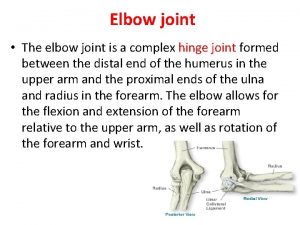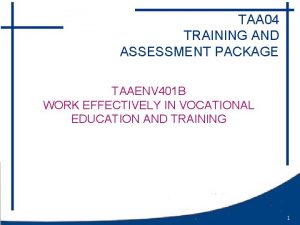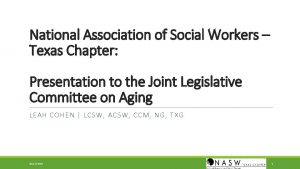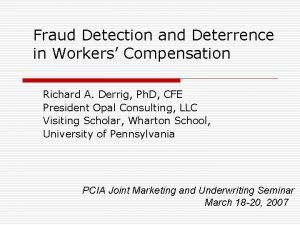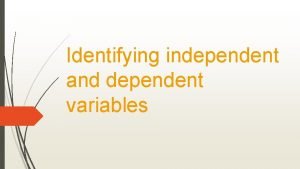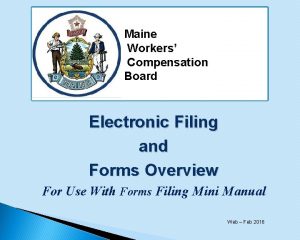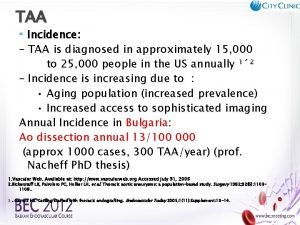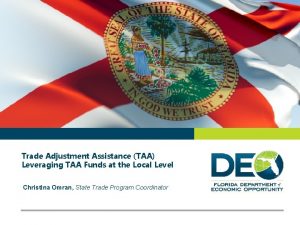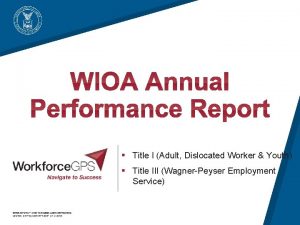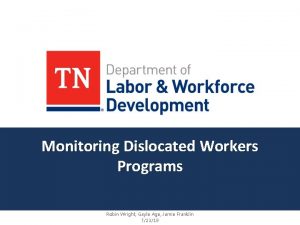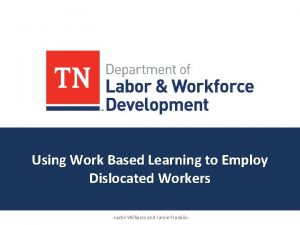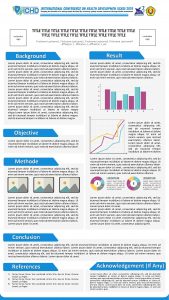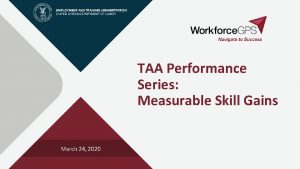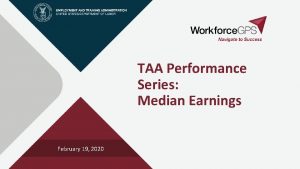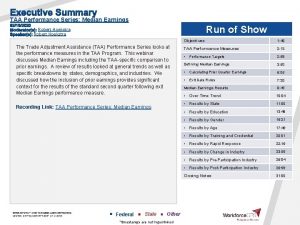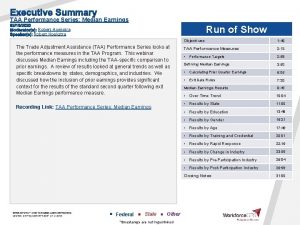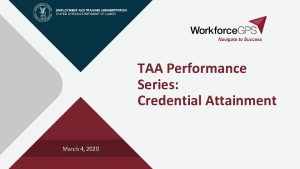Dislocated Workers TAA Performance Title I TAA What













































- Slides: 45

Dislocated Workers & TAA Performance Title I/ TAA

What is the definition of a Dislocated Worker?

WIOA Performance Regulations and Guidance • TEGL 10 -16 Change 1 Performance Accountability Guidance for Workforce Innovation and Opportunity Act (WIOA) Title I, Title III, and Title IV Core Programs • TEGL 19 -16 Guidance on Services provided through the Adult and Dislocated Worker Programs under the Workforce Innovation and Opportunity Act (WIOA) and the Wagner-Peyser Act Employment Service (ES • TEGL 14 -18 Aligning Performance Accountability Reporting, Definitions, and Policies Across Workforce Employment and Training Programs Administered by the U. S. Department of Labor • 20 CFR part 677; 34 CFR part 361; and 34 CFR part 463 Performance regulations

Primary Indicators of Performance

There are six (6) Primary Indicators of Performance for Dislocated Workers • Employment Rate 2 nd Quarter after Exit (Education/Employment for youth) • Employment Rate 4 th Quarter after Exit (Education/Employment for youth) • Median Earnings in the 2 nd Quarter after Exit • Measurable Skills Gains • Credential Attainment Rate – of those who received training or education, excluding OJT or Customized Training • Effectiveness in Serving Employers

How is the National Office calculating these performance metrics?

Employment Rate 2 nd Quarter after Exit is the percentage of participants who are in unsubsidized employment during the second quarter after exit from the program.

Employment Rate 4 th Quarter after Exit The Employment Rate 4 th Quarter after Exit is the percentage of participants who are in unsubsidized employment during the fourth quarter after exit from the program. Calculation includes all program participants.

Median Earnings – 2 nd Quarter After Exit The median earnings of participants who are in unsubsidized employment during the second quarter after exit from the program, as established through: • Direct Unemployment Insurance wage record match • Federal or military employment records • Supplemental wage information

Measurable Skill Gains (continued) Calculation includes all participants: The number of program participants during the reporting period who are in an education or training program that leads to a recognized postsecondary credential or employment and are achieving measurable skill gains based on attainment of at least one type of gain DIVIDED by the number of program participants during the reporting period who are in an education or training program that leads to a recognized postsecondary credential or employment. The number of program participants defined above who achieved at least one type of gain The number of participants who are in a program that leads to a recognized credential or employment


Credential Attainment Rate The Credential Attainment Rate is the percentage of participants enrolled in an education or training program who attain a recognized postsecondary credential or a secondary-school diploma during participation in or within one year after exit from the program. • High-School Equivalency diplomas are included • On-the-Job Training is excluded • Customized Training is excluded High-school diploma or its recognized equivalent is included in the percentage of participants who have attained a secondary school diploma or its recognized equivalent only if the participant also is employed or is enrolled in an education or training program leading to a recognized postsecondary credential within one year after exit from the program.

Credential Attainment Number of participants who exited during the reporting period who obtained a postsecondary credential during the program or within one year after exit -or Those who were in a secondary education program and obtained a diploma or its equivalent during the program or within one year after exit The number of participants enrolled in an education program (excluding OJT and customized training) who exited during the reporting period

Effectiveness in Serving Employers (Three Approaches) WIOA Sec. 116(b)(2)(A)(i)(VI) requires the Departments to establish a primary indicator of performance for effectiveness in serving employers. This indicator will be measured as a shared outcome across all six core programs within each State. Each State must select two of these three approaches to report on this indicator. • Retention with the same employer • Repeat Business Customers • Employer Penetration Rate Tennessee is using Repeat Business Customers and the Employer Penetration Rate. Additionally the Governor may establish and report on a third Tennessee-specific approach for measuring effectiveness

Repeat Business Customers Repeat Business will be used to asses our American Job Center’s ability to develop and maintain relationships with employers over an extended period of time. This is a unique count of employers who use WIOA core programs more than once. A business that uses AJC services can only be counted once per reporting period.

Employer Penetration Rate addresses the programs’ efforts to provide quality engagement and services to all employers and sectors within a State and local economy. Note: For employers with more than one physical location, each work site that receives services should be counted separately when receiving services.

How is TN currently performing now in our Dislocated Worker Program?

Current DW Outcomes as of PY 2018 Q 3 Core Performance Measures Negotiated Target Actual PY 2018 Q 3 Employment Rate 2 nd Quarter after Exit 81% 86. 9% Employment Rate 4 th Quarter after Exit 81% 86. 9% Median Earnings 2 nd Quarter after Exit $6, 900 $7, 865 Measureable Skills Gains Baseline 50. 4% Credential Attainment 68. 5% 74. 7%

National DW Rankings for PY 2017 Core Performance Measures Actual National Ranking Employment Rate 2 nd Quarter after Exit 89% #9 Employment Rate 4 th Quarter after Exit 88% #9 Median Earnings 2 nd Quarter after Exit $8, 190 #20 Measureable Skills Gains 41% #13 Credential Attainment 77% #23

Measuring Dislocated Worker Performance

Step 1: Go to Reports>Select Federal Reports

Step 2: Select WIOA Performance

Step 3. Select the ETA 9173 Note: The ETA 9173 allows staff to have all data in one report that staff can break down.

Step 4. Select the Program WIOA and the Customer Group Dislocated Worker

Step 5. Choose your Region and LWDB

Step 6. Select Date Type of Rolling 4 Quarter, select the Year 2018 and check the box next to the quarter you wish to view, then hit Run Report

The 9173 will then populate…

Section D will show staff the current and previous quarter percentages of the performance indicators. If Staff hit the hyperlink, it will allow a deeper dive into what participants fall into that measure.

After staff hit the hyperlink, this report shows the individuals within that measure…. .

The Numerator and Denominator are present on this report. By filtering properly, staff can see who has a negative result within the measure. Note: An “N” in the numerator column is a negative count against the measure.

All reports can be emailed or exported for further analysis and training.

Measuring TAA Performance

TAADI Scorecard

Trade Adjustment Assistance Data Integrity What are we doing to improve TAA outcomes and TAADI performance? • Monthly Program Technical Assistance Webinars for OSO’s, Lead’s, and Program Staff • Annual Training Conferences • Provider Training • Utilizing the TAADI Self-Check Score Card – – Goals met Goals missed Unofficial Performance Results Determine missing or incorrect data

TAADI Self-Check Score Card

TAADI Results Tab

Why should Dislocated Workers and TAA be co-enrolled?

TAA & DW Co-Enrollment Myth Busters Myth: Co-enrollment hurts WIOA performance. Busted: Performance improves with TAA participants are coenrolled with Title 1 DW (left table). The same is true for DW participants co-enrolled with the TAA program (right table).

Current DW Outcomes vs. TAA Outcomes Core Performance Measures DW Current Outcomes TAA Current Outcomes Employment Rate 2 nd Quarter after Exit 86. 9% 83. 3% Employment Rate 4 th Quarter after Exit 86. 9% 80. 7% Median Earnings 2 nd Quarter after Exit $7, 865 $8, 548 Measureable Skills Gains 50. 4% 80. 4% Credential Attainment 74. 7% 71. 8%

TAA & DW Co-Enrollment Myth Busters Myth: DW has limited funds, so TAA participants should be limited to TAA funds. Busted: • Co-enrollment requires that WIOA program funds must contribute to at least one service, which could include case management alone (in either one-on-one, or group settings). • There is no requirement that any portion of the training costs for TAA participants be funded by WIOA where participants are coenrolled. • There are many ways to coordinate co-enrollment that are a minimal cost burden for WIOA programs, including resume writing workshops, financial literacy, etc.

TAA & DW Co-Enrollment Myth Busters

TAA & DW Co-Enrollment Q & A

TAA & DW Co-Enrollment Q & A

TAA & DW Co-Enrollment Q & A

Any Questions?
 Whats a dislocated worker
Whats a dislocated worker Elbow bone
Elbow bone Taa ibs online test
Taa ibs online test Taa marbuta
Taa marbuta Pilot decision making
Pilot decision making Taa04
Taa04 Prefatory and supplementary part of proposal
Prefatory and supplementary part of proposal Title title
Title title Jcids process
Jcids process Chapter 11 performance appraisal - (pdf)
Chapter 11 performance appraisal - (pdf) Performance appraisal process
Performance appraisal process Workers wages and benefits module
Workers wages and benefits module Mobile workers definition
Mobile workers definition Basic training for barangay health workers
Basic training for barangay health workers Atypical worker meaning
Atypical worker meaning The factory workers were ready able
The factory workers were ready able National association of social workers texas
National association of social workers texas The harvest is plentiful but the laborers are few meaning
The harvest is plentiful but the laborers are few meaning Preventing cuts
Preventing cuts Native american skyscraper workers
Native american skyscraper workers Kingdom worker definition
Kingdom worker definition Advanced cities characteristics
Advanced cities characteristics Workers compensation court montana
Workers compensation court montana Youth readiness course
Youth readiness course Office workers admit being rude
Office workers admit being rude Community health workers
Community health workers Covid isolation health workers
Covid isolation health workers Ergonomics for healthcare workers
Ergonomics for healthcare workers 10 attitudes of successful workers
10 attitudes of successful workers Workers 1800
Workers 1800 Ethical and legal responsibilities of healthcare workers
Ethical and legal responsibilities of healthcare workers Gdss software examples
Gdss software examples Open ended questions social work
Open ended questions social work Workers compensation fraud detection
Workers compensation fraud detection Basic training for barangay health workers
Basic training for barangay health workers Did the ancient hebrews have specialized workers?
Did the ancient hebrews have specialized workers? Identifying dependent and independent variables
Identifying dependent and independent variables Forensic branches
Forensic branches Parable of the lifesaving station
Parable of the lifesaving station C.d.c. covid isolation health workers
C.d.c. covid isolation health workers Occupational health clinic for ontario workers
Occupational health clinic for ontario workers Maine workers compensation forms
Maine workers compensation forms Workers rights practice worksheet
Workers rights practice worksheet Web workers
Web workers Peko kooperativa
Peko kooperativa Www.or-hcc.org
Www.or-hcc.org

